#hunan changsha
Explore tagged Tumblr posts
Text
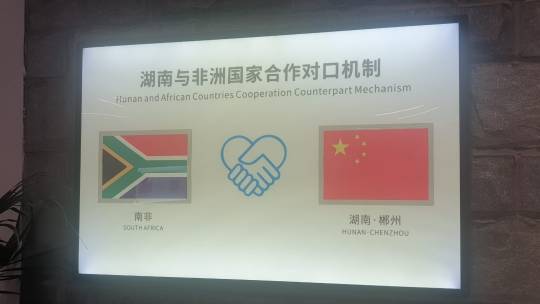

🌍🇨🇳🌍 China-Africa Trade Expo in Hunan Changsha: An Unforgettable Experience! 🌍🇨🇳🌍
Hey Tumblr fam! 🌟 Guess what? I recently had the most incredible adventure attending the China-Africa Trade Expo in the vibrant city of Hunan Changsha! 🌆 As a language enthusiast, this trip not only exposed me to the thriving trade relations between China and Africa but also opened my eyes to the immense cultural exchange that took place throughout the event. 🌏✨
Picture this: bustling trade booths filled with vibrant African goods, warm smiles from Chinese entrepreneurs, and the buzz of languages from across the globe coming together in harmony! 🎊🎉 The Expo showcased the deep economic ties between China and Africa, fostering opportunities for growth and development in both regions. 🤝📈
One of the highlights of my visit was the chance to connect with diverse individuals from different walks of life. 🤩 Amidst this melting pot of cultures, I realized the significance of breaking barriers through language. 🗣️ That's why I'm thrilled to share my latest discovery with you all - Jocelyn Wong's Udemy Course "Learn Chinese Language: Everyday and Business Chinese Beginner"! 📚🇨🇳
If you're like me, fascinated by the richness of the Chinese language and eager to dive into everyday and business Chinese, this course is an absolute gem! 💎 Jocelyn Wong, an expert language instructor, masterfully guides you through the fundamentals of Chinese, making learning enjoyable and effective. 🎓🏆
Through this course, you'll not only master basic conversations, but you'll also gain valuable insights into conducting business in the Chinese market - a skillset that's increasingly vital in today's global economy! 💼🌐
Whether you're planning to explore new trade opportunities like the China-Africa Expo or simply eager to enhance your language skills, "Learn Chinese Language: Everyday and Business Chinese Beginner" is your perfect companion. 🌟 Embrace cultural diversity, connect with people, and unlock exciting possibilities with the power of language! 🗺️🌈
Check out Jocelyn Wong's course on Udemy now: (Click here for link) and embark on your journey to becoming a confident Chinese speaker! 🚀🎯
ChinaAfricaExpo #HunanChangsha #LanguageLearning #ChineseLanguage #CulturalExchange #UdemyCourse #BusinessChinese #EverydayChinese #GlobalOpportunities #ExploreAndConnect
#learn mandarin#learn business chinese online#learn chinese in 5 minutes#learn chinese online#globalopportunities#exploreanddiscover#exploreandconnect#BusinessChinese#udemycourses#udemy online courses#cultural exchange#technology#hunan changsha#learn chinese 2023
0 notes
Text
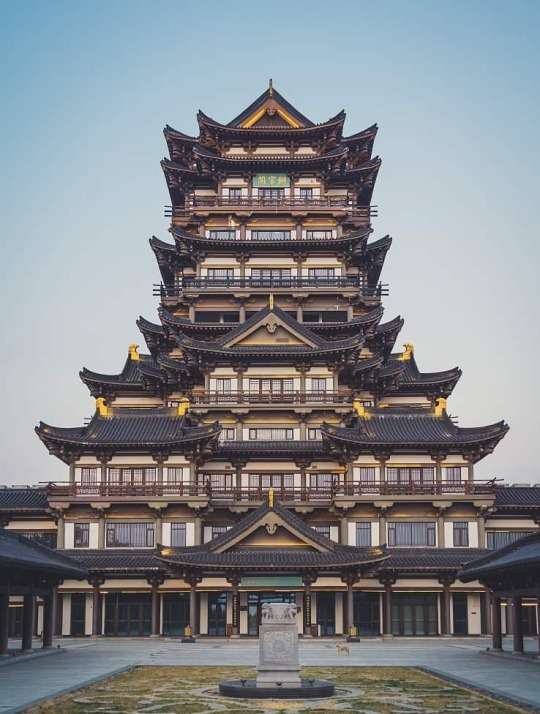
TONGGUAN KILN - CHINA
103 notes
·
View notes
Text


Wangcheng District, Changsha, Hunan Province.
30 meter high statue of Lei Feng's head, in his hometown.
2 notes
·
View notes
Text

Changsha, China
#changsha#china#night market#chinese#asia#market#neon lights#people#urban#travel#photography#dailystreetsnapshots#street#streets#life#hunan
29 notes
·
View notes
Text

0 notes
Text




Changsha mifen 长沙米粉 from Hunan province, Southern China.
#china#🇨🇳#Hunan province#Hunan#hunan food#hunan cuisine#chinese food#chinese cuisine#chinese culinary#chinese#chinese noodles#chinese rice noodles#noodles#rice noodles#street food#chinese street food#authentic chinese cuisine#authentic chinese food#hunanese food#hunanese cuisine#Changsha#Changsha rice noodles
1 note
·
View note
Text
Things to do in Changsha, China
Stuart Forster provides an overview of things to do in Changsha, the provincial capital of China’s Hunan province. Disclosure: Some of the links below and banners are affiliate links, meaning, at no additional cost to you, I will earn a commission if you click through and make a purchase. An introduction to Changsha The coach transfer from Changsha Huanghua International Airport to our hotel in���

View On WordPress
0 notes
Text




15/3/2024 - Dinner
📍 小吃王国, Changsha
It's off the main road, past the Uniqlo into some sort of gates. There are a few restaurants in the same area. This shop is one of them.
⭐️ Fish - freaking tender and not alot of bones
Veggies
⭐️ Beef with 3 chilis - super good, lots of garlic but way too spicy
Hong shao rou
Smoked blood sausage - tastes just like bacon
⭐️ Pickled long beans? - not sure what it is but it's hella tasty
0 notes
Text
Hello and welcome to one of our more relaxed post,today we don't talk about politics but something more enjoyable
The post is machine translated
Translation is at the bottom
The collective is on telegram




🥳 Sono giorni di vacanza in Cina. Dalla Festa di Metà Autunno (中秋节) alla Giornata Nazionale (中华人民共和国国庆节), la stragrande maggioranza dei Cinesi è in viaggio, e il turismo interno è fiorente 😍
⭐️ La mia amica 珍 è andata a Changsha, una meravigliosa città dell'Hunan. Qui, oltre a stupefacenti monumenti, e alla modernità della città, si può trovare una gigantesca statua che raffigura il volto di un giovane Mao Zedong 🚩
🇨🇳 Costruita tra il 2007 e il 2009, quando il Compagno Hu Jintao rappresentava il Nucleo Centrale della Causa del Socialismo con Caratteristiche Cinesi, questa statua ha tre caratteristiche peculiari:
一 È lunga 83 metri | Ciò simboleggia gli anni che ha vissuto il Presidente Mao Zedong (1893 - 1976) 😍
二 È larga 41 metri | Ciò simboleggia il numero di anni di leadership nel Partito Comunista Cinese del Presidente Mao Zedong. Dalla Guerra Popolare di Resistenza contro l'Aggressione Giapponese alla Fondazione della Repubblica Popolare Cinese, passando per l'Edificazione del Sistema Socialista di Base ⭐️
三 È alta 32 metri | Ciò simboleggia l'età del Compagno Mao Zedong quando scrisse la sua Poesia dedicata a Changsha ❤️
😘 «Da solo nel freddo autunnale,
sulla punta dell'Isola Arancione (橘子洲),
Lo Xiang scorre verso Nord,
Vedo colline cremisi, con i loro boschi fitti e tinti nel profondo,
e cento chiatte su acque cristalline... [...]» ����
❤️ Qui la Poesia completa 😍
🌸 Iscriviti 👉 @collettivoshaoshan 😘
🥳 These are holiday days in China. From the Mid-Autumn Festival (中秋节) to the National Day (中华人民共和国国庆节), the vast majority of Chinese people are traveling, and domestic tourism is thriving 😍
⭐️ My friend 珍 went to Changsha, a wonderful city in Hunan. Here, in addition to astonishing monuments and the modernity of the city, you can find a gigantic statue depicting the face of a young Mao Zedong 🚩
🇨🇳 Built between 2007 and 2009, when Comrade Hu Jintao represented the Central Core of the Cause of Socialism with Chinese Characteristics, this statue has three peculiar characteristics:
一 It is 83 meters long | This symbolizes the years that Chairman Mao Zedong (1893 - 1976) lived 😍
二 It is 41 meters wide | This symbolizes the number of years of leadership in the Chinese Communist Party of Chairman Mao Zedong. From the People's War of Resistance against the Japanese Aggression to the Foundation of the People's Republic of China, passing through the Construction of the Basic Socialist System ⭐️
三 It is 32 meters tall | This symbolizes the age of Comrade Mao Zedong when he wrote his Poem dedicated to Changsha ❤️
😘 «Alone in the autumn cold,
on the tip of Orange Island (橘子洲),
The Xiang flows north,
I see crimson hills, with their thick and deep-tinged woods,
and a hundred barges on crystal clear waters... [...]» 🥰
❤️ Here is the complete poem 😍
🌸 Subscribe 👉 @collectivoshaoshan 😘
#socialism#china#italian#translated#collettivoshaoshan#china news#communism#marxism leninism#marxist leninist#marxist#marxismo#marxism#mao zedong#mao#people's republic of china#chinese history#changsha#hunan
0 notes
Text


Ok, heading back in time to the Qin/Han period, we're continuing with the straight-edged robe, Zhiju (直裾) (previous Zhiju post is here).
This Zhiju robe is nicknamed the fish-tail robe as it cinches around the calf and then flares out at the bottom (like our mermaid dresses today). It's easily identifiable de to the very thick border around the bottom, and up along the side to the waist. The artefacts that were unearthed were all shorter in comparison to other Zhiju robes (easier to walk in...I should get one of these xD).
While researching for this robe I found out that the Hunan Museum (which hosts the Ma Wang Dui tomb exhibition) has an English site introducing some of the artefacts that were unearthed. If you're interested it's here: https://www.hnmuseum.com/en/content/changsha-mawangdui-han-dynasty-tombs-exhibition




#hanfu#汉服#china#中国#chinese hanfu#culture#history#fashion#clothing#historical clothing#直裾#战国袍#鱼尾袍#汉朝#马王堆#warring states robe#zhiju#han dynasty#ma wang dui
147 notes
·
View notes
Text
[Hanfu · 漢服]Chinese Warring States period(475–221 BC) Traditional Clothing Hanfu-Life of Qu Yuan(屈原)
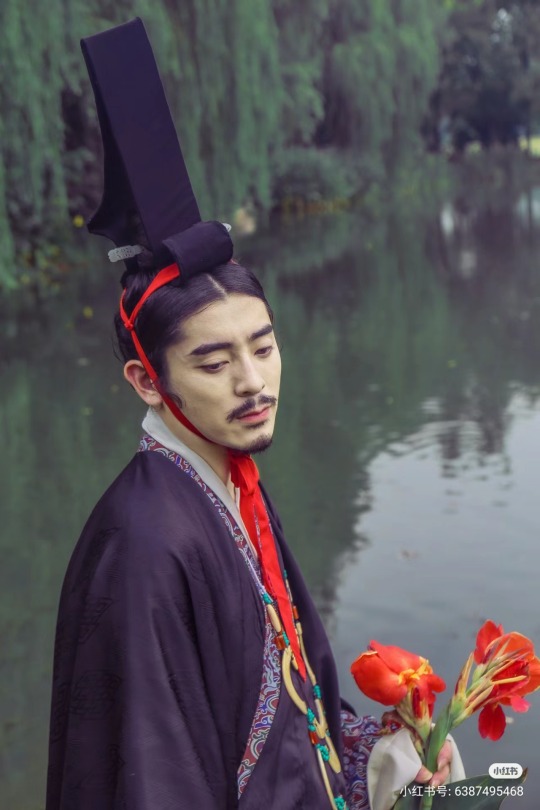
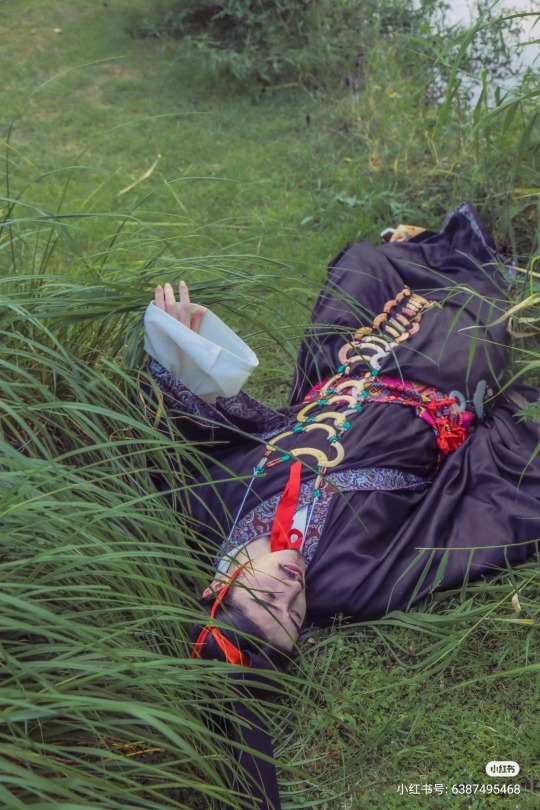
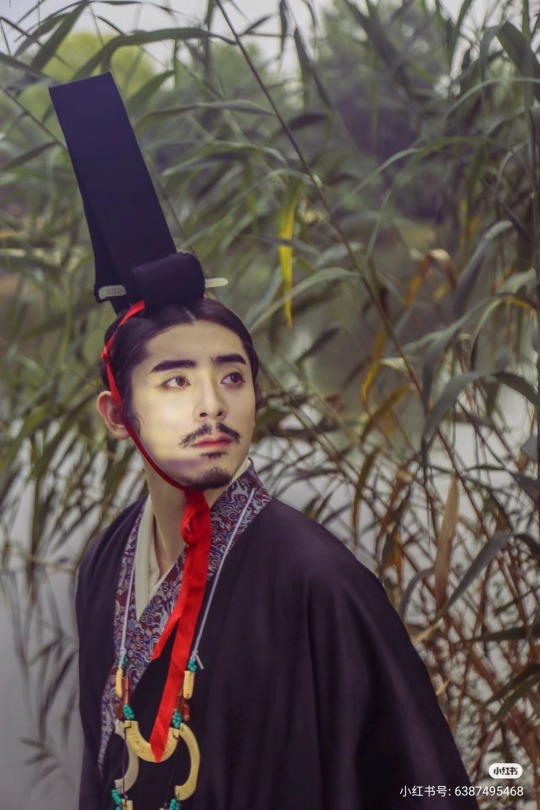

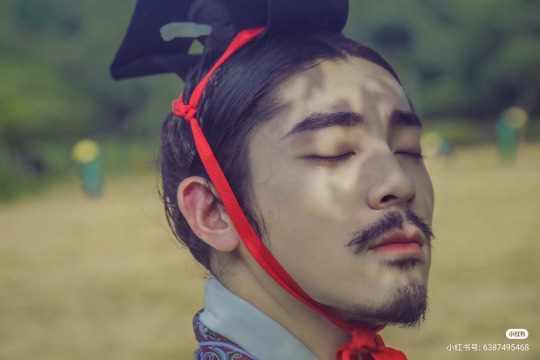

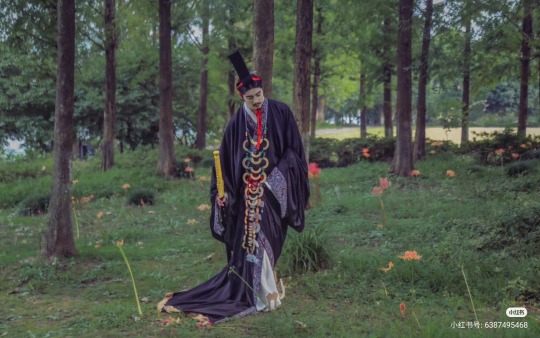
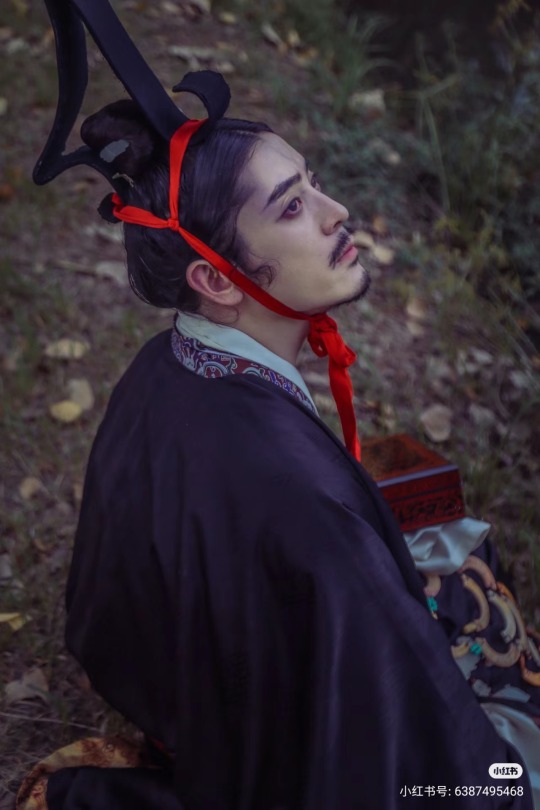
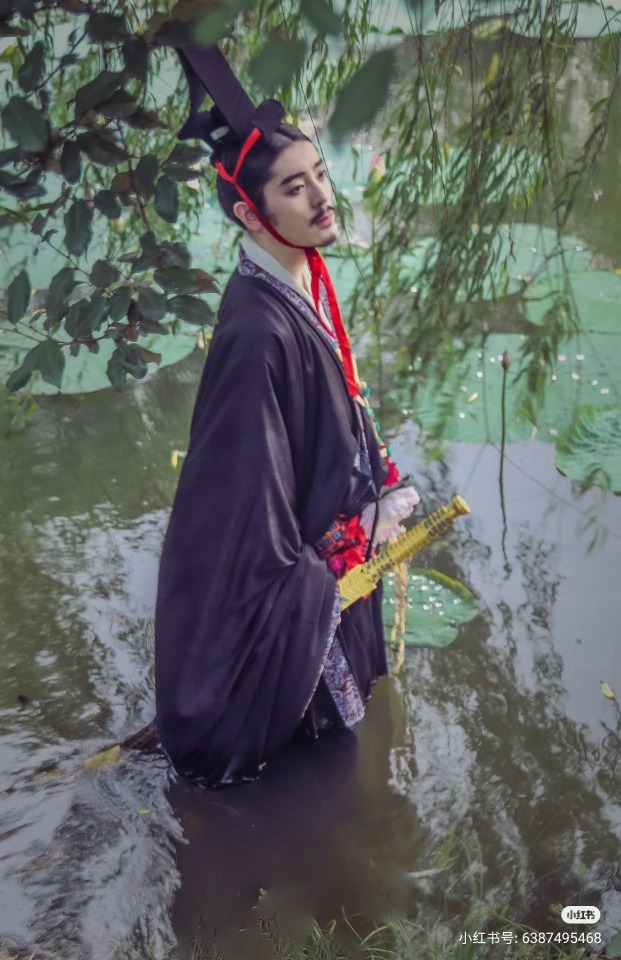
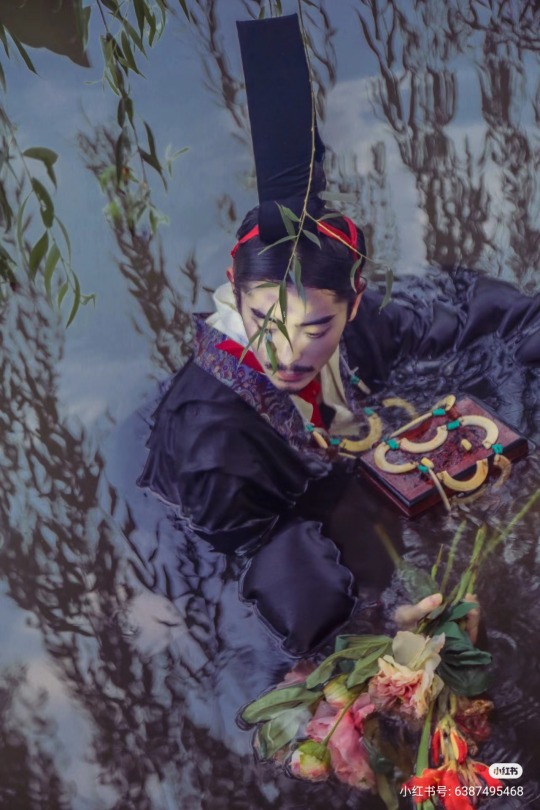
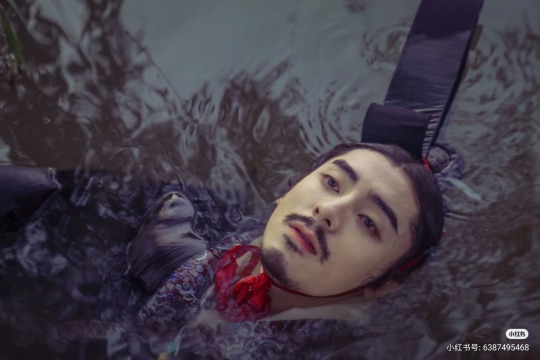

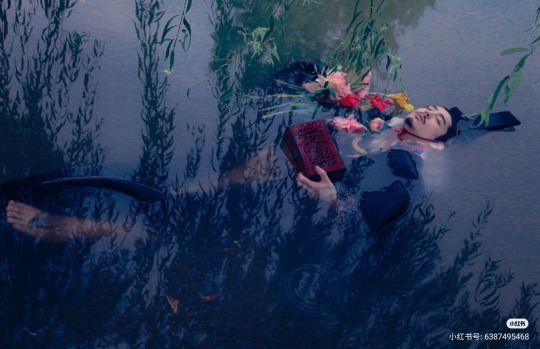
【Historical Artifact Reference】:
China Warring States period (475-221 BC):Silk painting depicting a man riding a dragon (人物御龍帛畫)
it was discovered in the Zidanku Tomb no. 1 in Changsha, Hunan Province in 1973. Now in the Hunan Museum
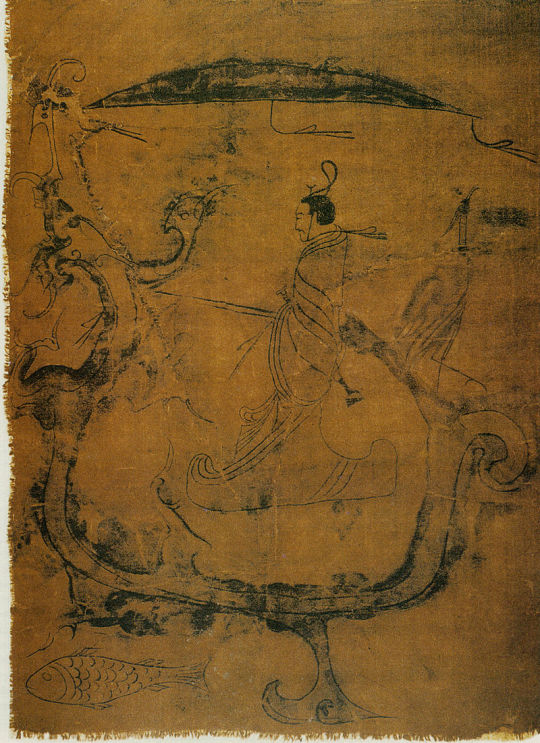
A man with a sword is riding a dragon by holding the rein. The dragon's body was given the shape of a boat. A little egret is standing at the tail of the dragon. A carp under the dragon is leading the way. The umbrella in the top middle of the picture shows the owner's nobility. The work has become associated with the Chu poet Qu Yuan’s famous verse from his poem Shejiang (涉江, Setting foot in the river), ‘Carrying a long sword with weird colour; Wearing a qieyun–styled high cap.” (帶長鋏之陸離兮, 冠切雲之崔嵬)
Western Zhou Dynasty seven-huang jade pendant with linked beads/西周七璜联珠组玉佩

About Qu Yuan(屈原)
Qu Yuan (c. 340 BC – 278 BC)was a Chinese poet and aristocrat in the State of Chu during the Warring States period. He is known for his patriotism and contributions to classical poetry and verses, especially through the poems of the Chu Ci anthology (also known as The Songs of the South or Songs of Chu): a volume of poems attributed to or considered to be inspired by his verse writing. Together with the Shi Jing, the Chu Ci is one of the two greatest collections of ancient Chinese verse. He is also remembered in connection to the supposed origin of the Dragon Boat Festival.
Historical details about Qu Yuan's life are few, and his authorship of many Chu Ci poems has been questioned at length.[4] However, he is widely accepted to have written "The Lament," a Chu Ci poem. The first known reference to Qu Yuan appears in a poem written in 174 BC by Jia Yi, an official from Luoyang who was slandered by jealous officials and banished to Changsha by Emperor Wen of Han. While traveling, he wrote a poem describing the similar fate of a previous "Qu Yuan."Eighty years later, the first known biography of Qu Yuan's life appeared in Han dynasty historian Sima Qian's Records of the Grand Historian, though it contains a number of contradictory details.
Life of Qu Yuan(屈原)
The only surviving source of information on Qu Yuan's life is Sima Qian's biography of him in Records of the Grand Historian (Shiji), although the biography is circumstantial and probably influenced greatly by Sima's own identification with Qu.Sima wrote that Qu was a member of the Chu royal clan and served as an official under King Huai of Chu (reigned 328–299 BC).
During the early days of King Huai's reign, Qu Yuan was serving the State of Chu as its Left Minister. However, King Huai exiled Qu Yuan to the region north of the Han River, because corrupt ministers slandered him and influenced the king.Eventually, Qu Yuan was reinstated and sent on a diplomatic mission to the State of Qi. He tried to resume relations between Chu and Qi, which King Huai had broken under the false pretense of King Hui of Qin to cede territory near Shangyu.
During King Qingxiang's reign, Prime Minister Zilan slandered Qu Yuan.[9] This caused Qu Yuan's exile to the regions south of the Yangtze River. It is said that Qu Yuan returned first to his home town. In his exile, he spent much of this time collecting legends and rearranging folk odes while traveling the countryside. Furthermore, he wrote some of the greatest poetry in Chinese literature and expressed deep concerns about his state. According to legend, his anxiety brought him to an increasingly troubled state of health. During his depression, he would often take walks near a certain well to look upon his thin and gaunt reflection in the water. This well became known as the "Face Reflection Well." On a hillside in Xiangluping (at present-day Zigui County, Hubei Province), there is a well that is considered to be the original well from the time of Qu Yuan.
In 278 BC, learning of the capture of his country's capital, Ying, by General Bai Qi of the state of Qin, Qu Yuan is said to have collected folktales and written the lengthy poem of lamentation called "Lament for Ying". Eventually, he committed suicide by wading into the Miluo River in today's Hunan Province while holding a rock. The reason why he took his life remained controversial and was argued by Chinese scholars for centuries. Typical explanations including martyrdom for his deeply beloved but falling motherland, which was suggested by the philosopher Zhu Xi of the Song dynasty, or feeling extreme despair to the situation of the politics in Chu while his lifelong political dream would never be realized. But according to "Yu Fu," widely considered to be written by Qu himself or at least, a person who was very familiar with Qu, his suicide was an ultimate way to protect his innocence and life principles.[citation needed]
Qu Yuan is said to have expressed his love for the ruling monarch, King Huai of Chu, through several of this works, including "The Lament" and "Longing for Beauty".
Dragon Boat Festival/端午节
Popular legend has it that villagers carried their dumplings and boats to the middle of the river and desperately tried to save Qu Yuan after he immersed himself in the Miluo but were too late to do so. However, in order to keep fish and evil spirits away from his body, they beat drums and splashed the water with their paddles, and they also threw rice into the water both as a food offering to Qu Yuan's spirit and also to distract the fish away from his body. However, the legend continues, that late one night, the spirit of Qu Yuan appeared before his friends and told them that he died because he had taken himself under the river. Then, he asked his friends to wrap their rice into three-cornered silk packages to ward off the dragon.
These packages became a traditional food known as zongzi, although the lumps of rice are now wrapped in leaves instead of silk. The act of racing to search for his body in boats gradually became the cultural tradition of dragon boat racing, held on the anniversary of his death every year. Today, people still eat zongzi and participate in dragon boat races to commemorate Qu Yuan's sacrifice on the fifth day of the fifth month of the traditional lunisolar Chinese calendar.
--------
Recreation Work by : @晴南
Xiaohongshu🔗:http://xhslink.com/CU2x9J
--------
#chinese hanfu#Warring States period(475–221 BC)#Qu Yuan(屈原)#State of Chu#china history#chines history#hanfu#hanfu accessories#hanfu_challenge#chinese traditional clothing#china#chinese#chinese aesthetics#chinese historical fashio#漢服#汉服#中華風#晴南#Dragon Boat Festival/端午节
184 notes
·
View notes
Text
ROUND 1: Wave 2


CONTENDER 1: XIN ZHUI
Also known as: Lady Dai, Marquise of Dai Age: 48-49 Location: Changsha, Hunan Province, China Means of Mummification: Airtight coffins (many!), air- and waterproof tomb, potentially an unknown acidic fluid containing salt and magnesium Notable features: Incredible state of preservation, full flexion of joints, stomach contents notable, valuable and ornate grave goods
CONTENDER 2: TOLLUND MAN
Age: ~40 Location: Silkeborg, Denmark Means of Mummification: Burial in an acidic and anaerobic peat bog Notable features: Perfect preservation of facial features, some skeletonization of hands and legs, stomach contents notable, some clothing and means of death preserved
#strong af mummy tourney#xin zhui#lady dai#tollund man#so to wit the model of lady dai isn't accurate but the newest more accurate one is apparently going through some controversy too#and i picked the kennis and kennis model of tollund man because he looks like a friend!!!!!
94 notes
·
View notes
Text
#TwoForTuesday :



Cranes and Serpents, 475-221 BCE (Warring States Period)
China, State of Chu (reportedly from Hunan province,Changsha)
Lacquered wood with polychromy
132.1 x 124.5 cm (52 x 49 in.)
On display at Cleveland Museum of Art 1938.9
“A different style of ritual art developed in the state of Chu in South China. In addition to bronze vessels, lacquered wood artifacts expanded the repertory of ritual implements.
This extraordinary sculpture was probably a drum stand for supporting a suspended drum in ritual ceremonies. It is unique among other excavated drum stands of the Chu, which typically show two birds standing on tigers. The theme of the bird stepping on the serpent was common in the Chu visual culture. Yet the slender proportions and seemingly flimsy structure of this particular set raise the question of whether it was utilitarian or mostly served symbolic functions in the tomb.
The birds' and serpents' bodies have designs painted in red lacquer and yellow pigment against the black lacquer. Scientific analyses confirm the additional use of a blue or green pigment that has been discolored over time.”
#animals in art#birds in art#museum visit#bird#birds#crane#cranes#serpent#serpents#snake#snakes#sculpture#polychrome#woodwork#lacquer#pair#Two for Tuesday#Cleveland Museum of Art#ancient art#Chinese art#musical instruments
23 notes
·
View notes
Text
The Fantastical Voyage of Young Dylan Wang (Translation)
by Renwu Magazine
2022-10-08

Author: Yi Huan Editor: Huai Yang Photography: Oliver June Makeup Artist: Bart Stylist: another d
Turning Points
At the age of 24, Dylan Wang has already experienced three major turning points in his life. The first two were entirely his own choices. In his original life trajectory, Dylan was supposed to be just another ordinary boy from a small-town community, inheriting his family's fried skewer shop after a few years of mediocre schooling, spending his days surrounded by smoke and grease.
At 14, he left Leshan for Chengdu to train as a flight attendant. Then at 19, he left Chengdu for Changsha—on a plane—where he participated in a Hunan TV talent show. He figured that, at worst, he could always return to being a flight attendant—a job he enjoyed for the chance to travel. But that trip put him on a reality show and ultimately made him an actor. From the smell of street food to the glitz of stardom, his life has been a series of extraordinary journeys.
His third major turning point happened in the summer of 2022 when he played Dongfang Qingcang in Love Between Fairy and Devil. The drama became one of the most popular historical fantasy romance series in recent years, attracting audiences for different reasons. On the surface, it followed the familiar trope of a domineering male lead falling for an innocent girl, but many viewers admitted to watching it as a “guilty pleasure.” For casual audiences, it was a thrilling watch, as the male lead was the most powerful warrior in the three realms, defying all rules. Feminist viewers appreciated the well-rounded and independent female protagonist. The high production value and visual effects even captivated male viewers who typically dismissed idol dramas. Others believed the series subverted traditional notions of strength, acknowledging loneliness and rekindling the possibility of love and connection. A media studies professor saw Dongfang Qingcang as a “progressive take on the overbearing CEO archetype,” stripped of toxic masculinity.
This widely beloved and well-received role gave Dylan Wang’s career a tremendous boost, making him the biggest beneficiary of Love Between Fairy and Devil. Yet just a year earlier, he had been its biggest "casualty."
A producer, who wished to remain anonymous, commented:
"For all the success he enjoys today, his failure back then was just as spectacular. Everyone treated him like a joke, you know? The backlash was brutal. It was total destruction—on the same scale as his current rise."
That Waterloo moment came in 2021 when Miss the Dragon aired. Dylan Wang played the Dragon King, and the reception was overwhelmingly negative. Online commenters mocked him for having the “acting skills of an AI” and compared him to a lifeless mannequin. His character, with straw-like unkempt white wig and an expressionless face, led to him being labeled the “ugliest historical drama male lead.”
The fallout from Miss the Dragon was relentless.. Wang Rouxuan, the producer of The Rational Life, later admitted that she had asked around about him. “If it had been at that time, would you all have opposed casting Dylan Wang as Qi Xiao?” The answer was a unanimous yes.
"But now you all love his portrayal of Qi Xiao," she countered.
"That doesn’t matter," they replied.
When Miss the Dragon premiered, Dylan Wang was already filming Love Between Fairy and Devil. Previously, he often spent his breaks playing with Lin Bo Rui, who played the supporting role of Shang Que. But during that time, he withdrew, quietly scrolling through comments about Miss the Dragon on his phone. His gloom wasn’t overbearing, but on someone as naturally cheerful as him, even subtle sadness was noticeable.
The director of Love Between Fairy and Devil, Yi Zheng, publicly defended him on Weibo but was met with ridicule. Some commenters asked if it was still possible to recast the male lead.
"Even the director got dragged down. They called him delusional," Dylan Wang recalled.
His boss, Lü Xiaojia, asked if he wanted to repost Yi Zheng’s message and respond, but he refused. He knew any response at that point would be meaningless.
He had only one option—to prove himself through acting.
While preparing for Dongfang Qingcang, he watched documentaries about lions to observe and mimic their regal, lazy demeanor. He listened to deep, heavy music and practiced expressions in the mirror. He also discussed his action scenes with the director and stunt coordinators. Unlike most dramas where powerful characters perform elaborate combat sequences, Dongfang Qingcang’s strongest attacks were minimal—just a hand movement or a snap of his fingers. Dylan Wang insisted, "The simpler the move, the stronger it feels."

A year later, on August 21, 2022, Love Between Fairy and Devil became the fourth drama on iQIYI to surpass 10,000 popularity points, joining My Heroic Husband, A Lifelong Journey, and Story of Yanxi Palace.
Dylan Wang was filming a variety show at the time. He hid in the rehearsal room and video-called Yi Zheng, clenching his fists and crying.
On Weibo, he wrote an emotional post: "Love Between Fairy and Devil is my redemption."
One day, he visited Wang Chuanjun and his wife, actress Qi Xi, and made them watch the drama. While they casually snacked, he earnestly explained each scene, analyzing how it was filmed and performed. They discussed it until 2:30 a.m.
Wang Chuanjun later praised his performance, calling it "stable."
"There was no excessive acting, nothing out of place. Everything was just right."
For Dylan Wang, Love Between Fairy and Devil was his third turning point. At the very least, he could now confidently say he was an actor. More importantly, he found camaraderie and brotherhood among his castmates—people just as passionate and idealistic as he was.
Director Yi Zheng declined an interview request from Renwu, but his influence was evident in the actors' accounts.
Dylan Wang once told Lü Xiaojia that during script readings, Yi Zheng had already personally sketched every key scene with precise musical accompaniment to enhance the mood. The effort and enthusiasm deeply moved him.
Li Xizi, who played King Beiyou, recalled how, after finishing an early edit of the scene where Dongfang Qingcang dives into the water to save the female lead, Yi Zheng excitedly sent it to the cast:
"Guys, this is incredible! I haven’t slept for two days because I’m so hyped about this scene!"
Lin Bo Rui also remembered Yi Zheng's enthusiasm, and how, after an intense scene where Dylan Wang’s character was tortured with frost salt spikes, Yi Zheng stopped filming and made the entire crew applaud for him.
"I’ve been in the industry for years, but I’ve never seen that happen before," Lin Bo Rui said.
In this fictional world, a group of young actors poured their real emotions into their work. Though the show used extensive CGI, many sets, including Dongfang Qingcang’s palace, were physically built.
On his first day on set, Li Xizi carefully examined the grand staircase, statues, and corridors. The moment felt surreal.
"We believed we were our characters. To this day, we still call each other by our roles."
When Dylan Wang was feeling down due to the criticism from Miss the Dragon, his friends didn’t offer words of comfort.
"We just said, ‘Forget it! Let’s go play basketball!’"
After a few days of basketball, Dylan had to leave Hengdian for other work. When he returned, they played again, and Lin noticed that Dylan was back to himself.
His biggest career setback since his debut 5 years ago had come and gone—and he had survived.
The Rise to Fame
Before Love Between Fairy and Devil aired, Lü Xiaojia, Dylan Wang’s manager, set a modest goal for the company’s PR team:
"Just get people to acknowledge that his acting has improved."
They never expected the show’s success to skyrocket him to trending status.
One day, before noon, Dylan Wang had already appeared in 13 trending topics—seven of which were in the top 10. Topics ranged from “Dylan Wang’s Studio Hiring Overnight” to “Dylan Wang Gained Nearly a Million Followers in a Day.”
"In the past, everyone worked hard to get on the trending list. Now, we’re just trying to reduce how often it happens," he said.
Every morning, his phone calls woke him up with work updates. Old variety show clips resurfaced, circulating widely. At airports, he was surrounded by fans. Even something as ordinary as going out for Lanzhou noodles was captured and posted online.
As summer ended with the conclusion of Love Between Fairy and Devil, young Dylan Wang had suddenly been thrust into the role of a “traffic star.” His journey into the surreal world of fame had officially begun.

The Gift of Happiness
In August 2022, anyone who tried to associate Dylan Wang with his Love Between Fairy and Devil character, Dongfang Qingcang, has experienced a stark contrast.
In the drama, Dongfang Qingcang was the most powerful figure in the Three Realms—a cold and domineering warrior who had severed all emotions for strength. But in real life, Dylan Wang was more like a "monkey", always bouncing around his friends, loud, playful, and full of unrestrained energy.
Producer Wang Rouxuan described him as the kind of person who would often be engaged in playful antics on set, once even yanking off her coat hood during filming.
When they were guests on Happy Camp, there was a children’s toy car prop on set. The car was so tiny that adults could barely fit into it, but Dylan Wang excitedly hopped on and zipped around the stage, much to everyone's exasperation. But you could tell, "he has his own world of happiness."
His close friend Li Xizi recounted a vacation with him in Aranya, where they went to a supermarket and saw water guns. Dylan held one up and dramatically asked, “Do I look cool?”
No matter where he was, he had to act cool.
They bought two water guns, and when they went out again, Li Xizi dressed up, hoping to take nice pictures. As soon as he stepped outside, Dylan Wang sprayed him in the face with water.
Another time, they went go-kart racing. By the third lap, Li Xizi was exhausted, but Dylan was still speeding around the track.
"Slow down, be careful!" Li Xizi shouted.
But before he could finish his sentence, Dylan had already sped past him.
"When he plays, he wholeheartedly commits to it. He takes everything seriously—even fun. When he shoots an arrow, he really believes he’s Houyi, the legendary archer."
Actor Lin Bo Rui also witnessed this side of Dylan Wang. While waiting between takes on Love Between Fairy and Devil, Dylan suddenly said, “I’m going to pluck your leg hair.”
He was completely serious.
Lin Bo Rui challenged him to rock-paper-scissors. He lost. Dylan immediately ran to the crew and grabbed a piece of strong adhesive tape. One swift rip—half of Lin Bo Rui’s leg hair was gone.
Lin Bo Rui demanded a rematch, but Dylan refused.
"This guy is hilarious," Lin Bo Rui laughed over the phone.
Dylan Wang always wants to win, even if the stakes are trivial. Both basketball and hip-hop were passions they shared. While waiting for makeup on set, they would challenge each other in mobile games. Whoever lost would sulk all day, itching for a rematch. If they wrapped filming early, they rushed to remove makeup, changed into casual clothes, and went straight to the basketball court.
Even in a team, Dylan Wang always wanted to take the final shot.
"Even if he's double-teamed, he has this burning desire to prove himself."

During a variety show, he once wore a ridiculous watermelon disguise—just to win a challenge. His idols—LeBron James, Sun Wukong, and Monkey D. Luffy—shaped his world. Their common traits? Passion, determination, and boundless energy. Happiness and childlike enthusiasm were integral to who he is.
Sometimes, his lightheartedness even broke through barriers, winning unexpected friendships.
Within the entertainment industry, actor Wang Chuanjun comes across as somewhat of a reclusive. When director Chi Yuan first met him on the variety show 50km Taohuawu (Wonderland), he worried that Wang’s strong personality might either clash with others or lead to social isolation. Before joining the show, Wang intended to keep to himself, lingering by the sea and tending to the vegetable garden. However, by the second day, Dylan Wang had already drawn him into the group’s activities.
Wang soon realized he had slipped into a familiar "fatherly role." Dylan kept dragging him to play basketball, much like how his daughter would tug at him at home, begging him to read picture books. "My daughter is always calling 'Daddy, Daddy,' and Dylan’s constantly saying 'Brother Jun, Brother Jun.' The tone is exactly the same." It felt as if he were looking after a son. To his surprise, he realized he had never once refused Dylan.
One day, during a storm, everyone stayed indoors. Dylan Wang suggested going outside. Wang Chuanjun and Olympic speed skater Wu Dajing agreed. They ran outside, playing frisbee and soccer in the pouring rain.
Chi Yuan observed this scene from the control room. At first, he thought it was "bizarre" and "utterly perplexing," but the production team quickly wiped the rain-drenched camera lens and captured the moment, which became an unexpected highlight of the show. In his conversation with Renwu, Chi Yuan remarked about Dylan, saying, "Dylan Wang single-handedly changed the whole show’s direction—turning it into something wonderfully ridiculous." This could only be achieved with an incredibly "silly," childlike mindset.
Wang Chuanjun later reflected, "It was so ridiculous that I thought, ‘I’ll never get another chance to do this in my life.’ Logic told me, ‘Are you crazy? It’s soaking wet, you’ll catch a cold.’ But my heart said, ‘I want to try it.’ And so I did. And it felt great."
He added, "A lot of my happiness comes from this guy."
On the show, Wang Chuanjun is often seen with his hair slicked back, unbothered by the sweat stains on his T-shirt as he diligently works in the garden, frequently stepping out of the frame. He appears incredibly relaxed, lost in his own world, but he always returns to the group. He believes that Dylan Wang is truly free-spirited, embodying a freedom of "doing whatever he feels like."
For example, when Dylan Wang wanted to go surfing, he simply went. Wang Chuanjun joked, "That bastard spent 200 contribution points on one surf session, while we had to work our asses off for those points."
One day, Wang Chuanjun and Wu Dajing hid the contribution points card. Dylan searched everywhere, frustrated.
"Screw it, I’ll just use my face to get in," Dylan suggested.
They burst out laughing and handed the card back to him.
After surfing, Dylan excitedly told Wang Chuanjun, "Bro, that was amazing! So good! What are we eating tonight?"
Just moments ago, he had been stressed. Now, it was like nothing had happened.
"That’s just how free he is—he doesn’t care what people think."
This kind of self-assurance never felt arrogant or off-putting. Instead, it made people feel at ease around him. This openness helped him make another friend on Taohuawu, comedian Li Xueqin. They bonded in a traditional way: after sharing a drink, "seeing each other's ugly sides," they became close. Li Xueqin, three years older than Dylan Wang, considered herself mature beyond her years, often referred to as "a 27-year-old body with a 40-year-old soul." She admired Dylan Wang’s "youthful energy," because he never seemed overly burdened, saying, "The way he speaks makes you feel like, I don’t have to be so miserable anymore."
Li Xueqin often posts emotional updates on her WeChat Moments, especially late at night. She says that when people feel upset, posting on Moments isn’t necessarily about solving the problem, but rather seeking attention. Those emo posts might be scrolled past by others, but Dylan Wang pays attention. He takes them seriously and will reach out to ask if something is wrong. Over time, he’s become adept at distinguishing when she’s just venting and when she’s truly troubled. Li Xueqin feels that Dylan Wang has a sensitive and subtle side.
Director Chi Yuan from Taohuawu also recalls an incident during a recording when Song Dandan mentioned being called overbearingly "suffocating" by internet commenters. Dylan Wang suddenly ran up to her, grabbed his neck, and joked, "I’m suffocating," effectively diffusing the awkwardness of the moment. On another occasion, when someone was feeling upset, Dylan brought over a bottle of beer. "He can sense the emotions of others and knows exactly how to comfort them. It makes me think that he’s both a naïve straight guy and yet deeply sensitive and thoughtful at the same time."
On Taohuawu, there was a segment called “Transcendent Conversations”—a form of performance art where participants dressed in white, gathered by the seaside, and took turns climbing a white ladder to have a “conversation” with someone beyond time and space.
Everyone else listened through their earpieces.
Before the recording, cast members nervously asked each other, “Did you write anything?” But then, they quickly changed the subject, as if avoiding their own vulnerabilities.
The biggest surprise came from Dylan Wang.
The guy who usually ran around like a madman had actually spent time alone, writing down his words in advance.
Then it rained, and his notes got lost. Panicked, he searched everywhere before realizing they had been soaked and stuck to the wall.
During the actual recording, one by one, people spoke to their future selves, their mothers, their grandmothers. Many broke into tears.
When Dylan Wang’s turn came, he climbed the ladder, adjusted his mic, and said:
"Hello, Luffy."
In the earpieces, Wang Chuanjun burst out laughing.
"Of course it’s him."
Standing before the vast sea, Dylan Wang continued:
"I hope I can be like you on my own journey…"
Then, he shouted into the microphone:
"Stay passionate forever! Stay sincere forever! Stay in love with life forever!"
In that moment, he was transparent—no pretenses, no careful calculations.
Wang Chuanjun later described him as “a shamelessly earnest idiot.”
But when others spoke about family, Dylan Wang removed his earpiece.
The program crew asked him why.
For once, his eyes turned red. He was clearly holding back his emotions.
"Family is something I don’t want to talk about on shows. I need to process it alone."
What he didn’t say was that in his five years in the entertainment industry, both his grandmother and grandfather had passed away.
When his grandmother died, he was filming Meteor Garden and didn’t make it back in time.
For someone usually so open, this was a rare glimpse into a deeply buried part of himself.
The director of Taohuawu, Chi Yuan, observed:
"He uses his cheerful personality to make others believe he’s always happy. But his sadness? He keeps that to himself. He hides it so well, pretending to be optimistic, because he doesn’t want people to worry about him. He just swallows it all."
Li Xueqin saw something similar:
"He has a rare kind of purity. Being friends with him is great because he finds everything funny. No matter what you say, he’ll nod, laugh, and cheer you on."
To her, happiness seemed easy and effortless when she was around him.
And yet, over the past two years, she started to believe that joy was more valuable than sadness.
"Being sad is easy. Being happy is hard. But he makes happiness look effortless. That’s why I think he’s special."

A Small-Town Boy
Director Yang Yang, who cast Dylan Wang in Ever Night 2, didn’t want just another pretty face. He was looking for an actor—When director Yang Yang was casting for the lead role of Ning Que in The King's Avatar 2, he sought a rugged young actor—someone who was more than just a "pretty face." Ning Que, the protagonist of Ever Night 2, grew up in hardship. He had no natural privileges, only sheer determination to survive.
This was the very quality that Yang saw as inherent in Dylan Wang. At the time, Wang was still relatively new to the industry, and Yang noted, “I felt he had that rawness, much like Ning Que.”
Unlike many rising stars, Dylan Wang never tried to hide his small-town roots. Born in Leshan, Sichuan, he came from a typical working-class family that struggled after the economic downturn of the 1990s. His parents opened a zha chuan (炸串, fried skewer) shop to make ends meet. If he wanted a bottle of Coke, he would have to help skewer food at the shop first.
Looks didn’t matter in his childhood, but from a young age, he knew he was attractive. Since kindergarten, he loved looking in the mirror, studying his own features. For a while, he was self-conscious about his “uneven eyes,” but he also grew accustomed to compliments. His parents often joked that he was "narcissistic," a label he embraced with pride, saying, “I like everything about myself.”
This beauty was a stroke of fate, but at the time, he had little awareness of its potential power. During summer and winter vacations, Dylan worked at the family’s skewer shop, a small-town version of Midnight Diner. It was here that he witnessed many of life's gritty, human stories. The shop was a microcosm of society—celebrations, gatherings, and also moments of sorrow and exhaustion. People came to fill their bellies, and the contrasting dynamics of joy and despair coexisted within the walls of the shop. There were drunkards, debt dodgers, street singers, and beggars. Even when he had just 1.5 yuan in his pocket, he would give away 50 cents to those in need.
One evening, late into the night, an elderly couple entered the shop and ordered a bowl of noodles. Amid the bustling activity of the busy skewer shop, no one seemed to notice them, except for Dylan Wang, who was just in third grade at the time. He observed that the elderly couple sat quietly at their table, with no food in front of them. Feeling compelled to help, he decided to act. Fried rice was quicker to prepare than noodles, so he approached them and asked, “Grandpa, Grandma, if you’re hungry, would you like to have fried rice instead?” After receiving their consent, he quickly prepared a bowl of fried rice and brought it to them.

After becoming an actor, these experiences left an imprint on Dylan, shaping his early understanding of performance. He never received formal acting training, but his friend He Kailang, a Beijing Film Academy graduate, saw parallels between Dylan’s time at his family’s fried skewer shop and the school's exercises in character observation. From a young age, Dylan passively encountered all kinds of people, and the shop exposed him to different facets of the world. Reflecting on it, he said he had viewed everything “with the purest, most untainted heart of a child.”
In early September, on the outskirts of Beijing, Renwu’s interview with Dylan took place in the evening. He had just wrapped up filming and changed into his own white T-shirt and jeans, visibly more relaxed. The lingering heat had faded, and as he ate biscuits, crumbs clung to the corner of his mouth. He effortlessly slipped back into the demeanor of a small-town boy. Few celebrities are willing to recount their past as ordinary people in such detail, but Dylan didn’t shy away from any questions. His words carried a lighthearted honesty, as if he had no reservations about anything.
For him, small-town life was a source of nourishment. Before opening the fried skewer shop, his parents worked at Long March Pharmaceutical, known locally as the Changyao Community—a self-sufficient, miniature commune where people were born, lived, and worked. Relationships there were simple and close-knit. He recalled his walk home from school, where he’d greet people along the way and catch the scent of home-cooked meals from every household.
His childhood friend Zhenyu, a year younger, lived in the building next door. Together, they were known in the community as the quintessential “free-range” kids. Unlike those confined to practicing piano or studying, they roamed freely—even after Wang’s parents sent him to school in the city, he’d return home at night to hang out with Zhenyu. Their group of six or seven, known in Leshan dialect as xiongdi huo (“brotherhood”), bonded over basketball, skateboarding, and the occasional fights. As the best basketball player in the group—and with a skewer shop that could treat everyone to drinks—Dylan naturally became the leader. Their group had principles: they never bullied younger kids. If older boys tried to steal their basketballs or trading cards, they retaliated with stones and spit. Wang was always the first to charge forward—cautiousness was never in his nature.
As night fell and the basketball hoop disappeared into darkness, Dylan and Zhenyu took turns walking their friends home. The courtyard had several steep slopes, and they rode their skateboards down, shouting at the top of their lungs.
But time moved on. Dylan Wang grew up, and the Changyao community faded into decline. He began to sense both the comfort and the confinement of small-town life. “I just felt like I didn’t belong there, like I was meant to leave.”
Had he stayed, his future would have been predictable: inheriting the skewer shop. His days would follow a rigid cycle—closing shop past midnight, sleeping until noon, eating lunch, spending the afternoon preparing skewers, serving customers until the early hours, then repeating it all over again. A loop with no exit.
At the time, Dylan had just finished middle school. If he remained in Leshan, his only option was vocational school—a path he knew would be even more aimless than before. He realized he had to break free. Then, as if on cue, an aviation school in Chengdu sent him a recruitment notice. At 14, Dylan stepped out of the loop and left small-town life behind, heading to Chengdu alone.
Dylan’s life has had its share of serendipitous turns. Just as he sought change, opportunities seemed to find him. Five years later, it happened again. While scrolling through Weibo, a Super Idol producer came across his profile and sent him a private message. Wang assumed it was a scam—but with his flight already booked for over 1,000 yuan, he figured he might as well go. At the time, he thought being a celebrity meant playing games on variety shows and making good money.
Years later, over drinks with Li Xueqin, Dylan shared the story of leaving home at 14. It was a moment of raw honesty between them. They had both left their hometowns at the same age—Li Xueqin left Tieling after middle school to study in Benxi.
To her, they came from the same world—the world of small-town youth. Growing up, they encountered people from all walks of life, developing an innate street sensibility and a deep connection to family. Moving to big cities, Li Xueqin noticed that many people referred to their aunts and uncles as relatives, but she had never seen them that way. “They’re not just relatives—they’re family.” She and Dylan shared the same core trait: “We both just really want our parents and family to have a good life. When we make choices, we always put family first.”
Stepping into the wider world required courage, and in their solitude, they built new relationships, forging deep bonds with friends. Many people interviewed for Renwu described Dylan Wang’s unwavering loyalty. In early September, Hunan TV producer Xia Qing visited Dylan Wang on set. He was filming a show designed to help new entrepreneurs, which involved a six-hour live stream. The production team had sent Wang a last-minute invitation, and to Xia Qing’s surprise, he accepted immediately. Both she and producer Chen Xinyu had given Wang opportunities on major variety shows in the past, and Wang hadn’t forgotten. “He said that because Director Chen believed in him back then, he would come—even if it meant a same-day round trip.”
Li Xueqin observed that many people who move to big cities try to shed their small-town identity, eager to blend in. But she and Dylan weren’t like that. Writer Wang Rouxuan noted that many people categorize their friendships into past and present, but Dylan never made such distinctions. To him, they were all part of the same continuum. When Zhenyu became a photographer, Dylan specifically invited him to take his portraits. Once, Wang Rouxuan asked him what he’d do if he stopped acting. His response was immediate: “I’d go back to Leshan, of course. Be with my brothers. I’d still be happy there.”
During Xia Qing’s visit, Dylan mentioned that their skewer shop had been getting more customers lately, keeping his father busy. She asked if he’d consider having his father close the shop to take a break. He shook his head. “It’s what they’ve done their whole lives.” She then asked if he’d change the shop’s outdated signboard. His answer was simple: “If my dad likes it, that’s all that matters.” “Every decision he makes is rooted in family,” Xia Qing noted. “He doesn’t care about anything else.”
When Renwu requested an interview with Dylan’s mother, she declined, saying she was too busy with work. Lü Xiaojia, who had met Wang’s family, recalled arranging for his parents to visit him on his birthday one year. As they walked, his mother instinctively held onto his arm. Lü Xiaojia saw in that moment the love that had shaped Dylan Wang. “He grew up surrounded by love—and that’s why he knows how to give it.”
Even though he had left home, he had never severed his ties. Instead, he built his own world—one filled with love, loyalty, and lasting connections. A world where he received love and knew how to give it back.

Maintaining the Rough Edges
When producer Wang Rouxuan first met Dylan Wang, she was searching for a lead actor for The Rational Life. From a distance, she spotted him at a photoshoot, dressed in Louis Vuitton, his hair slicked back, striking poses for a magazine cover. Her first instinct was to leave. She had no interest in producing an idol drama—she needed an actor with authenticity.
She didn’t get the chance to walk away. They eventually met at a café, where Dylan had changed into his own clothes: an old tank top, loose-fitting pants, and flip-flops. His hair was an unkempt mess, sticking out in all directions. He spoke at length about his childhood in Leshan. Wang Rouxuan was struck by how unfiltered he was—very few actors would present themselves so unvarnished in front of a producer.
"Casting ordinary people to play ordinary people is essential," she said. She had met many actors who had spent their whole lives in the industry—"their heads seem to glow," she remarked. Immersed in film sets from a young age, their identity as an actor had long overshadowed any other part of their existence. Dylan, however, remained unmistakably a regular person. "And that part of him—the authenticity—is deeply ingrained. It needs to be protected."
In an industry where many walk on eggshells, terrified of missteps, Dylan was different. He wasn’t afraid to show his imperfections. Rather than crafting a meticulously curated public image, he presents himself as an actual person—flawed, unfiltered, and approachable.
At first, these rough edges manifested as youthful recklessness and an almost oblivious fearlessness. At 19, Dylan entered the talent show Super Idol. Li Xizi first met him there, at the airport. Neither of them made a great first impression on the other. It was a transitional season—Li Xizi was still bundled up in a trench coat, while Dylan had already switched to short sleeves.
Over time, they grew familiar. Eventually, they ended up sharing a room. While most contestants eagerly introduced themselves to the show’s guest stars, Dylan and Li Xizi stayed holed up in their room, each lying on their bed. "Should we go out?" Li Xizi asked. "Forget it. Let’s just stay here," Dylan replied—until the director eventually dragged them out.
Halfway through the first episode, they realized the show wasn’t just "a fun gathering of good-looking guys"—contestants were going to be eliminated. Li Xizi felt his stomach drop. He turned to Dylan and asked, "If I get eliminated, what will you do?" Dylan replied, "Then we’ll leave this goddamn place together."
Dylan had no standout talents, making him a prime candidate for elimination. However, He Jiong, one of the show’s hosts, intervened. "Dylan has a face that audiences will love," he said, securing his place in the competition.
Dylan’s looks became his saving grace. Another host, He Bing, was unimpressed by him, but instead of eliminating him, the show imposed a challenge—Dylan had to wear a mask and would only be allowed to remove it if he placed first in a challenge.
When the mask was handed to him, Dylan furiously hurled it to the ground.
Li Xizi, watching from the sidelines, was livid. He thought it was unfair. Later, He Jiong calmed Dylan down, and he apologized, staying in the competition. To help Dylan win first place in a challenge, Li Xizi and another contestant, He Kailang, rehearsed tirelessly. Their performance in the third episode was well-received, but just as the results were about to be announced, other contestants began questioning the fairness of the outcome. Unable to hold back, Dylan stormed forward, escalating the situation into chaos. He Jiong, frustrated, canceled the first-place ranking entirely.
Later, the director informed Li Xizi that Dylan had actually won the challenge. Li Xizi was devastated. He ran up to Dylan and slapped him twice. "We stayed up night after night rehearsing, all because of you. I told you not to overreact!" He expected Dylan to retaliate, but Dylan just stood there, tilting his head slightly under the mask, silent.
Li Xizi stormed off. A while later, Dylan walked over, nudged him, and casually said, "Are you eating?" And just like that, the two were fine again.
"Thinking back, we were so melodramatic—just staring at the sky, getting mad over these things," Li Xizi said, now lounging on a company couch, reminiscing about those three months on Super Idol. "To this day, he’s the only friend I’ve ever had in this industry who I feel has absolutely no ulterior motives. That show put us through so much. We fought through every challenge together, just the two of us, side by side."
As someone who had entered the industry two years before Dylan, Li Xizi often played the role of an overprotective "mother hen." During Super Idol, whenever they were on a flight, Li Xizi insisted on sitting next to Dylan. Dylan, with his carefree attitude, would immediately fall asleep. His head would sometimes lean toward Li Xizi, other times toward the girl sitting next to him. Li Xizi stayed alert the entire flight, ready to yank Dylan back if he leaned the wrong way.
By the seventh or eighth episode, Li Xizi realized that despite being the only non-professional contestant on the show, Dylan was fully capable of handling himself. "He truly understands what to do in key moments. His way of handling things is always right."
In 2017, Lü Xiaojia was casting for the mainland Chinese remake of Meteor Garden, serving as the show's producer at the time. The Super Idol team sent her some recommendations, and when she saw Dylan Wang’s photo, she was immediately intrigued. He was dressed in a light blue suit, wearing aviator sunglasses, striking a pose in front of a plane. "At first glance, the picture looked ordinary," Lü said, "but you could immediately tell he was incredibly handsome."
She convinced Meteor Garden’s director, Angie Chai, to attend an episode taping of Super Idol. However, when Chai returned, she said she hadn't found anyone suitable. The success of the original Meteor Garden had set an incredibly high standard, and Dylan was far from what she had envisioned for the new Daoming Si. But Lü insisted that this adaptation needed Dylan’s face.

His good looks had given him an advantage. Lü Xiaojia had spent time analyzing Dylan Wang’s facial features. His eyes and nose were what impressed her the most—his eyes were large and expressive, his nose sharp and well-defined, yet softened by a rounded tip. His face was incredibly versatile—it could be charming or domineering, righteous or roguish. It fit seamlessly into the mold of a shōjo manga male lead, making him a natural fit for Meteor Garden.
She flew to Changsha to meet him in person. After the meeting, she told him, "You can enter our F4 training program."
Dylan’s response was immediate: "Can I play Daoming Si?"
"Is that the only role you want?" Lü asked. His characteristic bluntness surfaced again.
"Of course," he said. "I want to be the leader."
For many, the 2001 Taiwanese Meteor Garden was a defining piece of youth culture. The 2018 mainland Chinese version aimed to tell a new story, but its production was influenced by changes in the drama market. Distributors insisted that the remake should cater to a Gen-Z audience, which led to a more juvenile interpretation of the story. The stark economic disparity between the male and female leads—a core tension in the original—had to be toned down, weakening much of the drama’s impact.
When the series aired, it was widely mocked. This reaction all but ensured that Dylan would not be shaped into a traditional, flawless idol. Lü Xiaojia, who had by then signed him as his manager, made a deliberate decision—she would not shy away from his imperfections. His off-key singing, his unpolished Mandarin, his awkward English—none of it would be hidden. "Who wants to watch someone without any flaws?" she reasoned.
This strategy aligned with Dylan’s own instincts. At 19, still a complete outsider to the entertainment industry, he understood a fundamental truth: "I’m not perfect. If you make me look too polished, people will tear me down. It’ll backfire."
He remained unfazed by the industry’s rigid etiquette. Lü once gave him a list of "dos and don’ts" for actors: no spicy food, no salty food, no alcohol. "Every eyelash, every strand of hair—you have to treat them as part of your professional toolkit," she warned. Dylan, naturally, found this absurd.
Yet, if asked who was the most disciplined artist in the company, Lü would name him without hesitation. "I once told him, ‘Discipline brings freedom.’ He thought I was talking nonsense, but he actually listened.
His social interactions are also guided by his instincts. After filming Ever Night 2, Dylan Wang remained in touch with director Yang Yang. When he heard that he was in Hengdian filming A Dream of Splendor, he immediately texted him and brought him some fruit. Yang remarked that while maintaining contact was easy, doing so consistently over several years was rare.
Now, Li Xizi has no concerns about Dylan handling fame. "I know him too well. He'll never do anything unexpected. He’s always clear about what he’s doing, the consequences, and where to draw the line."

Brilliant, But Not Overwhelming
After the new Meteor Garden aired, Dylan Wang was dubbed "the poorest Daoming Si in history." At the time, Li Xizi comforted him, saying, "It's better to be criticized than ignored." He recalled his own first acting role, where he played a minor character following the female lead around. "I told him, 'Think about it—your first role is Daoming Si, the leader of F4!'"
They weathered the ups and downs of the industry together. After a difficult period, Li even considered quitting. He felt out of place in the entertainment world. On variety shows, he refused to use labels or curated personas to introduce himself, and his lines were often cut. He was emotionally driven—if he was feeling down, he wouldn’t show up for work. When a good opportunity came his way, his first thought was always, Do I even deserve this? On set, his nervousness was evident—his left cheek would twitch on the monitor from sheer tension. After filming Unchained Love with Dylan, the director told him, "Tell your friend he’s actually doing great, but he overthinks everything."
Li Xizi also came from a small town—Shennongjia. From middle school, he was certain he wouldn’t stay there forever. He first worked as a fashion editor, then as a staff member for celebrities, before eventually being scouted by a talent agency. He admitted that he once had the same unrestrained energy as Dylan, able to throw himself into life without hesitation. But the longer he spent in the entertainment industry, the more he fluctuated between confidence and self-doubt.
This kind of self-inflicted self-doubt and mental exhaustion is a symptom of the times, but Dylan, even after five years in the industry, has remained unscathed. Li Xizi explained, "When faced with the same situation, I might overanalyze it, coming up with eight different explanations for why something happened. But Dylan just acts—he does what needs to be done, and when he’s finished, he moves on. Simple as that."
"He’s really full of energy," Li continued. "Sometimes when I get caught up in negative thoughts, he’ll just say, ‘What’s the big deal? Right?’ He doesn’t see problems as insurmountable obstacles. If something goes wrong, you fix it. If a mistake happens, you figure out why and make sure it doesn’t happen again. That’s just how he is."
Even now, they meet up frequently. Whenever Dylan returns to Beijing from work trips, he always makes sure to let Li know he’s back. On a deeper level, Li has noticed a shift—Dylan has gone from being the one constantly seeking advice to the one offering support. "Sometimes, having a carefree attitude isn’t a bad thing," Li admitted. "Having Dylan around helps me regain my confidence. It’s a reminder to stay energetic."
Over the past five years, Li has felt that Dylan still carries that fearless energy. He recalled an incident on Super Idol when Dylan had to apologize. He stood on stage, closed his eyes, and shouted toward the ceiling, Teacher He, I’m sorry! Remembering this, Li burst into laughter. "He’s still the same Dylan."
Director Chi Yuan noted that most celebrities have a strong sense of self-preservation. Before taking on any task, they carefully consider what they’ll say and how they’ll prepare. But Dylan doesn’t bother with any of that—he rarely thinks about himself as a celebrity at all. At the beginning of the year, he became a regular cast member on Hello, Saturday, and he treats the set like his own home. Showrunner Fu Jiapeng described him as being like "a sparkling iced Americano—always energetic, always refreshing."
When Love Between Fairy and Devil became a massive hit, Chi Yuan visited Song Dandan’s home and casually mentioned, "Dylan is really popular right now." Song immediately called Dylan in a video chat to give him some words of advice. Chi Yuan recalled Dylan’s response: Don’t worry, Sister Dan, I’m in great shape—physically and mentally!
Li Xueqin described Dylan as someone who "shines brightly, but never blinds you." She explained, "He radiates warmth, and his presence is comforting rather than overwhelming. He never overshadows anyone."
"With a friend like him, it’s impossible to feel jealous," she continued. "You just want him to succeed because he genuinely deserves it. He’s so likable. Even after achieving this level of fame, he hasn’t changed—he’s still just as warm and unpretentious. As his friend, you just know that no matter how big he gets, no matter how far apart we might be, our friendship won’t be affected." She smiled, "That’s why he deserves to succeed—because he can succeed."

Creating His Own Quiet Space
After leaving 50kim Taohuawu, Dylan Wang experienced the busiest August of his life. Backstage at Hello, Saturday, Li Xueqin spotted him and teased, Well, well, look who’s the hottest star now. Dylan brushed it off with a casual, Oh, cut it out.
What does it really feel like to be "traffic"—a viral sensation?
"It’s pretty stressful. It’s scary. Really scary," Dylan admitted.
During the peak of Love Between Fairy and Devil’s success, he even wondered, Should I tone myself down? Should I stop being so goofy and spontaneous? Do I need to act more like Dongfang Qingcang all the time so people will like me?
But he quickly abandoned that thought. "I still need to be my real, vibrant self. Dongfang Qingcang is my character—that story belongs in Love Between Fairy and Devil. But my own story has only just begun."
One evening in September, his manager Lü Xiaojia visited his home. Sunlight streamed through the floor-to-ceiling windows, casting a golden glow. Dylan was lounging in a beanbag chair, dressed in a black tank top, a hair tie holding back his slightly disheveled bangs, his eyes focused on the book in his hands.
Lü’s immediate reaction was: Are you putting on a show for me?
Two months prior, after finishing 50kim Taohuawu, Dylan had told Lü that he had made two new friends—Wang Chuanjun and Li Xueqin. He also declared that he was going to start reading books seriously. No one at the agency believed him. They all thought he was joking.
But something had indeed shifted.
While filming Taohuawu, there was a moment when Dylan, Wang Chuanjun, and Xu Zhisheng were walking back to their rooms. The other two were deep in conversation about a book they were both reading. Dylan had nothing to add—he felt out of place. I sound so unversed in literature right now, he thought.
Back in the room, Wang Chuanjun decided to introduce him to an episode of Thirteen Talks, featuring historian Cho-yun Hsu. Dylan watched for five minutes before nearly dozing off. Wang, undeterred, kept nudging him, Just listen carefully. Try to appreciate the depth of his thoughts and wisdom. He forced Dylan to watch another ten minutes, but Dylan still couldn’t get into it.
But that same night, after they had all gone to bed, Dylan suddenly spoke up.
"Bro, that thing you showed me at noon—can you play it for me again?"
That night, Dylan watched the entire episode by himself.

Signs of being more calm may have begun there. Later, they often ventured to the beach in the middle of the night to gaze at the stars. Beneath the starlight, their conversations always turned to family. On one occasion, during a heartfelt conversation in the early hours—with no production director present and no microphones in use—the fixed camera merely captured the two of them drinking. Wang Chuanjun described the atmosphere that night with a gesture: “Two men holding hands, taking photos of the shadows on the beach.” He hoped Dylan Wang could find moments of stillness in his career. "Being able to sit alone in silence for a while—it’s something that really nourishes you."
Do you remember that line? In Super Idol, Dylan once said to Li Xizi, “Let’s get out of this damn place.” Looking back, that was just a playful remark among brothers. At that time, he did not yet understand what it meant to be a celebrity; now, after the events of that month, he has a much clearer grasp of it. “Really? You might never be as free as you once were—you have to relinquish many privileges,” he reflected.
“I feel that these sacrifices are my due, as if it were simply fate—this industry demands that you pay an equal price. It’s like working at a fried skewer shop, enduring long, sleepless nights in a continuous cycle. Our industry is unique; you end up giving more than you ever thought, and that is the reality of this profession,” Dylan said.
A once carefree young man now had to navigate complexity. The Lanzhou ramen shop, once a frequent hangout for him and his friends, became off-limits after he was photographed there. He could see the staff bustling around because of his presence, he reflected, "You never know what might happen or how things might be interpreted. I don’t think this is just about me," he said. "So I can’t afford to be too self-indulgent."
Lü Xiaojia once advised him that in the past, you only needed to consider whether you liked something, but now you must also weigh interpersonal dynamics, the expectations of fans, the needs of collaborators, and the platform itself—how to achieve a balance. “So what can you do? It’s simply an inevitable part of growing up.”

As the sky darkens, the interview with Dylan Wang for Renwu magazine draws to a close. There are still many questions, and he’s still thinking, without any answers.
The answer itself isn’t what matters. In an increasingly high-strung entertainment industry, Dylan Wang has managed to preserve his natural instincts and intuition. Despite the pressures around him, he continues to approach the world with a sense of wonder and unguarded enthusiasm, radiating an infectious vitality. He represents a different kind of celebrity—one that feels refreshingly unfiltered. Perhaps he will change with time, but for now, he remains genuine—and that, in itself, is rare and valuable.
His friends, however, have simpler wishes. They hope that Dylan Wang can be happy and carefree. When the story of Lanzhou hand-pulled noodles reached Wang Chuanjun, he took on a different interpretation. After finishing his phone call with Renwu, Wang Chuanjun said he wanted to call this young friend. In his view, it’s unnecessary to shoulder the responsibility for him. "When too much is piled on him, he can’t create anything new."
Whether as an actor or as a young man, "he should continue to live freely so that he can grow better."
Before the recent commotion and turmoil occurred, in Taohuawu, another heavy rainstorm arrived. Wang Chuanjun sat on a tatami mat in the hallway, watching the rain. Dylan Wang walked over, and to his surprise, he didn’t try to drag Wang Chuanjun into something. Instead, he sat down beside him.
The sky before them was particularly striking. On the left, dark clouds, lightning, and rain loomed, but the clouds were moving quickly. On the right, the sun was slowly emerging, and light began to shine through. Dylan Wang sat there, watching the sky for half an hour.
On the day Lü Xiaojia visited Dylan Wang’s home, standing by the French windows, with a copy of The Stranger by Camus — a book recommended by Wang Chuanjun — he had already read most of it. That afternoon, Dylan Wang had just finished recording a program in Changsha and returned to Beijing. He spent the evening dealing with work, and the next day he was set to fly to Shanghai for an event, with barely any time to rest. Quietness is a luxury in this era, and even more so for him. At his busiest, caught between tension and anxiety, he created a moment of peace for himself.
He quiets down, trying to comprehend the more complicated world around him. Dylan has already unknowingly changed in many ways this summer. But when it comes to the rules of fame and his new reality akin to The Truman Show, this young man, who has just stepped into the industry, remains both naive and prideful about his future. Much like his beloved Sun Wukong, he scratches his ear and wonders, "Then perhaps I should try to fight back?"





#dylan wang#wang hedi#interview#miss the dragon#love between fairy and devil#unchained love#this is probably essential reading for every dylan fan
19 notes
·
View notes
Text
Fei Kai (费凯), better known by her stage name Pixie (픽시) is a fictional Chinese/Korean American Singer and dancer. she's the only female member of the co-ed group Stray Kids. She debuted in Stray Kids as a Main dancer, Sub rapper and lead vocalist in the month of March 25th, 2018; after her participation in the pre-debut survival show, Stray Kids. At this time, Pixie is the 1st most credited 4th gen female artist with 76 song credits, 5th/6th most credited 4th gen artist overall.
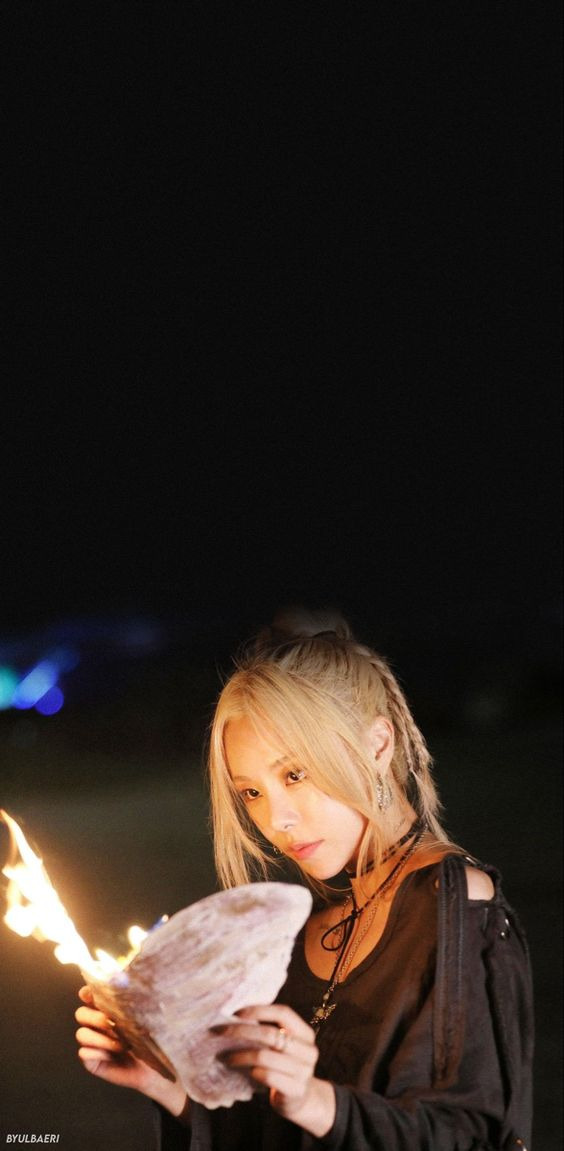

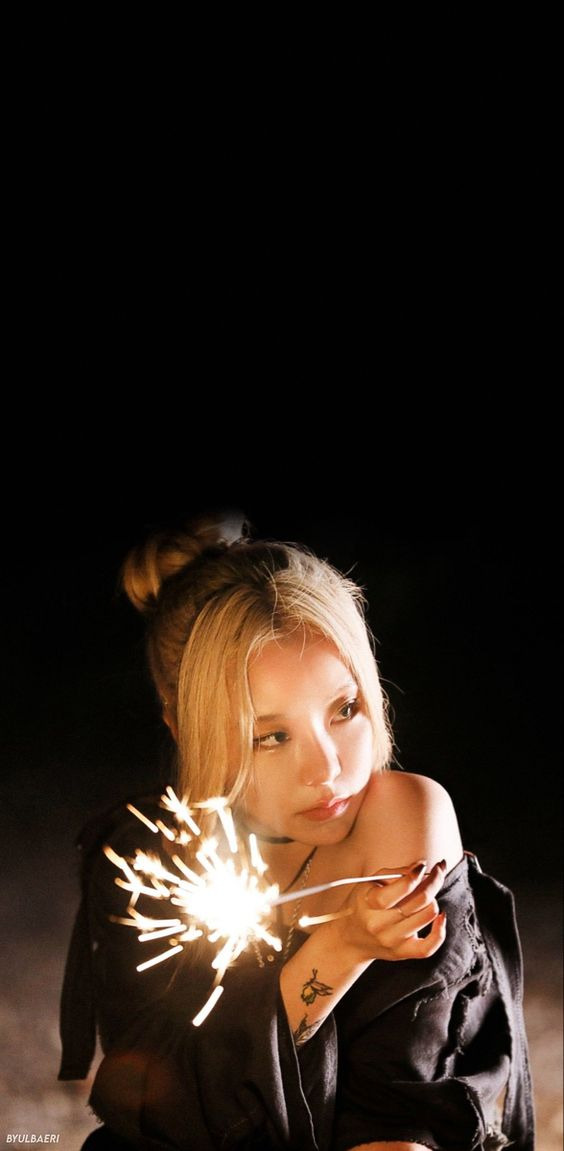
⍣BASIC INFORMATION ! ⍣
STAGE NAME : Pixie (KR:픽시) BIRTH NAME : Fei Kai (MN:费凯 KR: 페이 카이) KOREAN NAME : Fei Seung-hee (KR: 페이승희) ENGLISH NAME : Kate/Katy Fei NICKNAMES : Pix, Kiki, Vocal Siren, Nation’s Girlfriend, K-pop's little sister BIRTHDAY : November 8th, 2001 ZODIAC SIGN : Snake and Scorpio BIRTH PLACE : Changsha, Hunan Province, China NATIONALITY : Korean-Chinese American FAMILY : Fei Hao (Father; Deceased), Lee Hye-jin (Mother; Deceased), Fei Bo (Older brother), Fei Jen (Sister-in-law; Deceased), Fei Di-a (Niece), Fei Il-Seong (Nephew) LANGUAGES SPOKEN : English (Native), Mandarin (Native), Korean (Native), Japanese (90%), Thai (85%), Cantonese (50%), Hindi (45%)
⍣PHYSICAL ! ⍣
HEIGHT : 160 cm (5’3 - barely) BLOOD TYPE : O- BODY MODIFICATION : Lobe piercings, tongue piercing, Five tattoos ( x, x, x, x, x [along her upper spine in large characters]) FACE CLAIM : Mamamoo's Jung Whee-in and Itzy's Yeji VOICE CLAIM : Mamamoo’s Jung Whee-in mixed with Pink Fantasy’s Yechan (x and x) DANCE CLAIM : Kaycee rice and Redy (x and x)
⍣PERSONALITY ! ⍣
MBTI : INFJ (the Advocate) MBTI TYPE : A personality type with the Introverted, Intuitive, Feeling, and Judging traits. They tend to approach life with deep thoughtfulness and imagination. Their inner vision, personal values, and a quiet, principled version of humanism guide them in all things. POSITIVE TRAITS : Patient, creative, Passionate NEGATIVE TRAITS : Sensitive to criticism, Perfectionist, short-tempered
⍣STATICS ! ⍣
DANCE : 10/10 VOCAL : 10/10 RAP : 6/10 STAGE PRESENCE : 9.5/10 VARIETY : 7/10 SONGWRITING : 10/10 ACTING : 9/10
⍣ CAREER INFORMATIONS ! ⍣
STAGE NAME : 픽시 AGENCY : jyp entertainment GROUP : Stray Kids DEBUT DATE : March 25th, 2018 POSITION(S) : Main dancer, sub rapper, lead vocalist, Maknae INDIVIDUAL FANDOM : Feiries, hatchlings REPRESENTATIVE EMOJI : 🦚/🐲 UNIT : VocalRacha (Also in; Puppyracha, Englishracha, Cultracha, Paboracha) SPOTIFY : Screaming and crying but make it upbeat
⍣ FACTS ! ⍣
Helps her members with english
Refuses to call her members Oppa, it's only her members she does this with
Wanted to use her name as a stage name, but since her name is typically a masculine name, her personal manager thought it would be a good idea to use Pixie instead
Doesn't post on many socials, but is a professional lurker
Has had media training, but she's unhinged and doesn't use it much
One of the buffest female idols out there
Most flexible
Her and Seungmin are called the Puppy Siblings due to their puppy-like visuals
Hates aegyo. Cringes any time any one of her members does it, except for Changbin
Her hobbies include learning languages. Whenever she's overwhelmed, she speaks several languages at once
Originally was supposed to be the 4th member of Danceracha but because of her vocal talent and stability, she became the 3rd member of Vocal Racha
More...



Taglist: @mynameisnotlaura
#skz 9th member#9th member of stray kids#skz#skz 9th female member#skz imagines#skz x reader#bang chan#hyunjin#han jisung#jypartists#Skzkaifei#changbin#lee know#jeongin#lee felix#seungmin
42 notes
·
View notes
Text
the fact that yibo-official’s ip address for that post is hunan ( changsha is the capital ). means he is possibly there. he really tried but what’s important is his health. there have been so many times that he put his health second because of work commitments and i’m perfectly fine with him not attending the road shows till he is okay.
i know we are all worried but i hope we don’t overthink and make up scenarios. let him rest. it’s gonna be fine. 🫶🏼
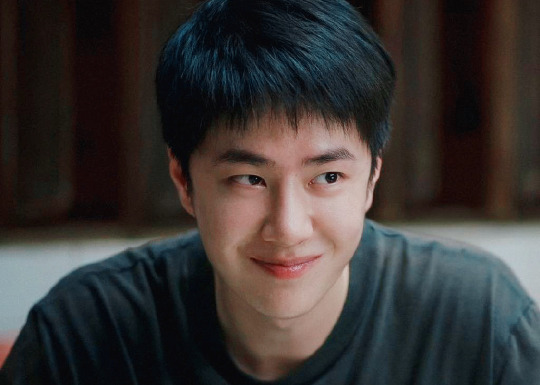
#wang yibo#get well soon kid 😌😌😌#i hope he gets better soon so he can celebrate his bday with energy!#this is a reminder to take care of yourselves too!!!!#lol i should take my own advice on this 😅😅😅
70 notes
·
View notes